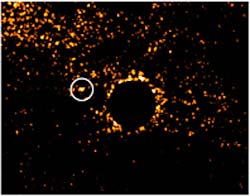First Search in Stellar Graveyard Yields Two Possible Planets

Shown here is one of the 20 target white dwarfs of our survey. The white dwarf is at the center of the image and has been masked out. North is up and east is to the left. Nearby to the east is a candidate companion (circled), which if associated would be a massive planet or low mass brown dwarf. It needs further observations to confirm or refute its association with the white dwarf.
Astronomers are announcing today the first results of a search for extrasolar planets and brown dwarfs in an unlikely place–the stellar graveyard. The report, titled “Searching for Extrasolar Planets in the Stellar Graveyard,” is being presented at the American Astronomical Society meeting in San Diego, California, by John Debes, a graduate student at Penn State; Steinn Sigurdsson, associate professor of astronomy and astrophysics at Penn State University; Bruce Woodgate, of the NASA Goddard Space Flight Center, and their collaborators. These results are particularly interesting because they answer some questions about the presence of planets around stars that are more massive than the Sun.
The research team found two candidate planets in its survey of 20 dead stars–white dwarfs at distances between 24 and 220 lightyears–with three telescopes: the Near-Infrared Camera and Multi-Object Spectrograph on the Hubble Space Telescope, the Canada France Hawaii 3.6-meter (150-inch) Telescope, and the Gemini North 8-meter (300-inch) Telescope. White dwarfs are small, dense, Earth-sized objects that are the leftover corpse of a star that has run out of enough fuel to shine brightly but was once as massive as–or several times more massive than–the Sun. The researchers had calculated that they should be able to detect planets with a mass 10 times that of Jupiter if any were present around most of the white dwarfs, and as small as five times the mass of Jupiter around a few of them, but they detected only two promising candidate planets among the 20 white dwarfs they studied. “You have to be careful with a candidate planet because it often is just a background object,” says Sigurdsson. “Since all of our candidates are incredibly faint, we cannot obtain spectra for them to identify whether they are a planet, a brown dwarf, or a background galaxy.”
To determine whether the candidates are planets, the Sigurdsson team now plans to take two snapshots of each over a period of several months to a year. “Each target white dwarf moves across the sky about 1/3000 of the diameter of the full moon every year, whereas background objects do not appear to move at all,” Debes explains, “so if a candidate moves with the white dwarf that would show that the two are physically associated and the candidate is a planet in orbit around the white dwarf.”
The team earlier had detected three candidate planets that they found to be background objects after taking a second image. “If the two remaining candidates also are background objects, that discovery would indicate the frequency of planets around white dwarfs is quite small, though a larger sample of white dwarfs must be studied to more accurately gauge their frequency,” Sigurdsson explains.
Because it is nearly impossible with current telescopes to see a planet around a nearby star as bright as the Sun, Sigurdsson’s team searched around near-by white dwarfs, whose dim glow is much less likely to obscure a companion planet. A white dwarf is up to thousands of times dimmer than the Sun and the contrast between it and a planet several times Jupiter’s mass is about a factor of ten thousand less. “If we could find such a planet, then we can use the evidence it provides, like forensic investigators, to tell what the planetary system was like when the star was alive,” Debes says.
The research is part of an intense race to take the first “photograph” of an extrasolar planet. Astronomers seek to compare the picture of an extrasolar planet with various theories about how such planets should look. This comparison will help reveal how the solar system formed and how frequent life may be in the Milky Way galaxy. Further discoveries are expected when larger and more sensitive telescopes are built that can better detect Jupiter-size planets.
This research was supported by the Penn State Astrobiology Research Center and the NASA/ESA Hubble Space Telescope, which is operated by the Association of Universities for Research in Astronomy, Inc., under NASA contract NAS 5-26555. These observations are associated with program #9834.
Media Contact
More Information:
http://www.psu.eduAll latest news from the category: Physics and Astronomy
This area deals with the fundamental laws and building blocks of nature and how they interact, the properties and the behavior of matter, and research into space and time and their structures.
innovations-report provides in-depth reports and articles on subjects such as astrophysics, laser technologies, nuclear, quantum, particle and solid-state physics, nanotechnologies, planetary research and findings (Mars, Venus) and developments related to the Hubble Telescope.
Newest articles

High-energy-density aqueous battery based on halogen multi-electron transfer
Traditional non-aqueous lithium-ion batteries have a high energy density, but their safety is compromised due to the flammable organic electrolytes they utilize. Aqueous batteries use water as the solvent for…

First-ever combined heart pump and pig kidney transplant
…gives new hope to patient with terminal illness. Surgeons at NYU Langone Health performed the first-ever combined mechanical heart pump and gene-edited pig kidney transplant surgery in a 54-year-old woman…

Biophysics: Testing how well biomarkers work
LMU researchers have developed a method to determine how reliably target proteins can be labeled using super-resolution fluorescence microscopy. Modern microscopy techniques make it possible to examine the inner workings…





















